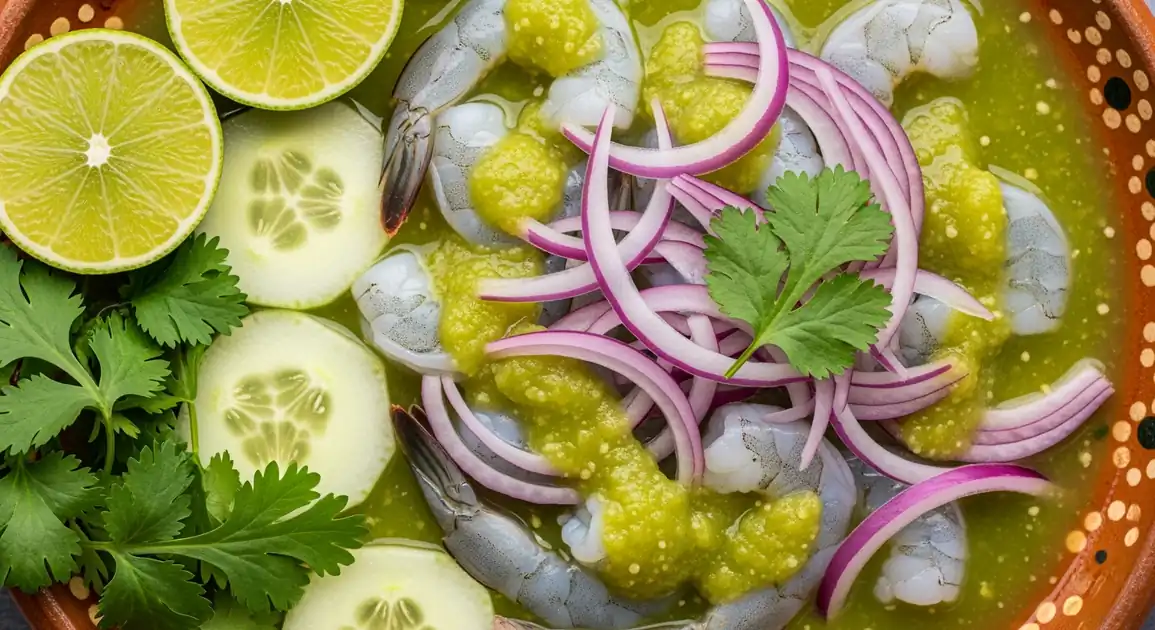Aguachile
Aguachile

Description
Despite being inland, Mexico City offers excellent aguachile thanks to efficient seafood transportation networks from coastal regions. The city's culinary innovation has led to creative interpretations of this traditionally coastal dish, ranging from strictly traditional preparations to modern fusion versions with unique ingredients and presentations.
Dietary Information
Serving information
Serving style
In Mexico City, often served with additional garnishes like avocado, mango, or chicharrón. Many upscale restaurants use decorative plating with modern presentations, while traditional marisquerías serve in simple molcajetes or shallow clay dishes with ample tostadas.
Quick facts
Most quality marisquerías in Mexico City operate from 12 PM - 8 PM, with some extended hours on weekends. Seafood market stalls typically open earlier (8 AM - 5 PM).
Safety Tips
What to Look For
-
Translucent, plump shrimp or fish
Properly fresh raw seafood should appear somewhat translucent, firm, and moist. Avoid seafood that looks opaque, mushy, or has discolored edges.
-
Refrigerated display case for seafood
Proper refrigeration is essential for raw seafood safety. Look for establishments with visible refrigeration for their seafood.
-
High customer turnover
Busy restaurants cycle through ingredients faster, meaning seafood is less likely to sit around. This is especially important for raw dishes.
-
Clean preparation areas
Visible kitchen cleanliness indicates good food handling practices and reduces cross-contamination risk.
-
Made-to-order preparation
Aguachile should ideally be prepared to order, not sitting pre-made, to ensure optimal freshness and texture.
What to avoid
-
Strong fishy odor
Fresh seafood should smell clean and oceanic, not fishy. A strong fishy smell indicates decomposition has begun.
-
Grey or discolored shrimp
Shrimp should be a translucent greyish-blue when raw (or pinkish if briefly lime-cured). Avoid yellow, black spots, or unnaturally white appearance.
-
Pre-prepared aguachile sitting out
Since aguachile continues to 'cook' in lime juice, pre-made batches can become tough and potentially unsafe if left too long.
-
Cross-contamination signs
Watch for staff handling raw seafood and other foods without changing gloves or washing hands.
-
Warm serving temperature
Aguachile should be served chilled. Room temperature or warm raw seafood dishes present significant safety risks.
Price information
Price range
Budget tips
- Lunch specials ('comida corrida') at marisquerías in neighborhoods like La Condesa often include aguachile at better rates (180-250 MXN).
- Market stalls in Mercado de San Juan or Mercado de Coyoacán typically offer lower prices than restaurants.
- Order during 'hora feliz' (happy hour) specials at seafood restaurants, especially weekdays.
- Seafood restaurants in Colonia Escandón or Doctores typically offer better value than those in Roma or Polanco.
Value indicators
- Fresh, translucent shrimp without fishy odor.
- Balanced sauce with noticeable chile heat and acidity.
- Generous portion size relative to price.
- Complementary garnishes and tostadas/crackers.
- House-made salsas or additional condiments included.
Where to Find This Dish
Colonia Roma & Condesa
Trendy areas with high concentration of quality seafood restaurants, both traditional and innovative.
Contramar, El Pescadito, Colonia Roma market area
Lunch (1 PM - 3 PM), Weekend afternoons
Mercado de San Juan
Famous market with specialty seafood vendors known for exceptional quality.
Seafood section of Mercado de San Juan
Morning (10 AM - 12 PM), Early afternoon
Colonia Del Valle
Home to several traditional marisquerías with loyal local clientele.
Mariscos El Paisa, Fisher's
Lunch (1 PM - 3 PM)
Polanco
Upscale district with innovative seafood restaurants featuring creative aguachile versions.
Palmares, La Docena
Lunch, Dinner
Vendor Tips
- Ask for 'aguachile del día' (aguachile of the day) for the freshest preparation.
- Many Mexico City vendors receive seafood deliveries Tuesday through Friday mornings, making these days optimal for freshness.
- Restaurants offering overly extensive menus beyond seafood specialties may not focus on seafood freshness and quality.
- Look for restaurants that specify their seafood's coastal origin (e.g., 'camarones de Sinaloa' or 'pescado de Nayarit').
How to Order
Regional Variations
-
Aguachile Capitalino
(Aguachile Capitalino)
Mexico City's adaptation often features additional ingredients like avocado and mango, sometimes with a touch of habanero for extra heat.
-
Fusion Aguachile
(Aguachile Fusión)
Creative interpretations in upscale restaurants might incorporate Japanese influences (yuzu, soy sauce) or unexpected ingredients like grasshopper salt (sal de chapulín).
-
Vegetarian Innovations
(Innovaciones Vegetarianas)
Mexico City leads in plant-based adaptations, with mushroom or hearts of palm versions available in progressive restaurants.
-
Contramar Style
(Estilo Contramar)
Following the famous restaurant's interpretation, this style features perfectly butterflied shrimp and a balanced, less aggressively spicy sauce.
Cultural context
History
Aguachile originated in the coastal state of Sinaloa in northwestern Mexico, traditionally prepared by mountain-dwelling ranchers using dried chiltepín chiles crushed with water to create a spicy liquid for preserving and flavoring dried meat. As the dish evolved and reached coastal areas, fresh seafood (primarily shrimp) replaced meat, and fresh lime juice was incorporated to 'cook' the seafood. Now popular throughout Mexico and internationally, the dish represents the perfect marriage of inland chile culture with coastal seafood traditions.
Local significance
In Mexico City, aguachile represents coastal flavors brought inland and has become a staple of weekend social dining. It's particularly popular among younger diners and foodies exploring Mexico's diverse culinary landscape.
Eating customs
- In Mexico City, it's common to add a few drops of Maggi sauce or Salsa Huichol for extra flavor.
- Often eaten alongside other seafood appetizers like tostadas de atún or pulpo.
- Locals know to squeeze extra lime and add salt to customize to their preference.